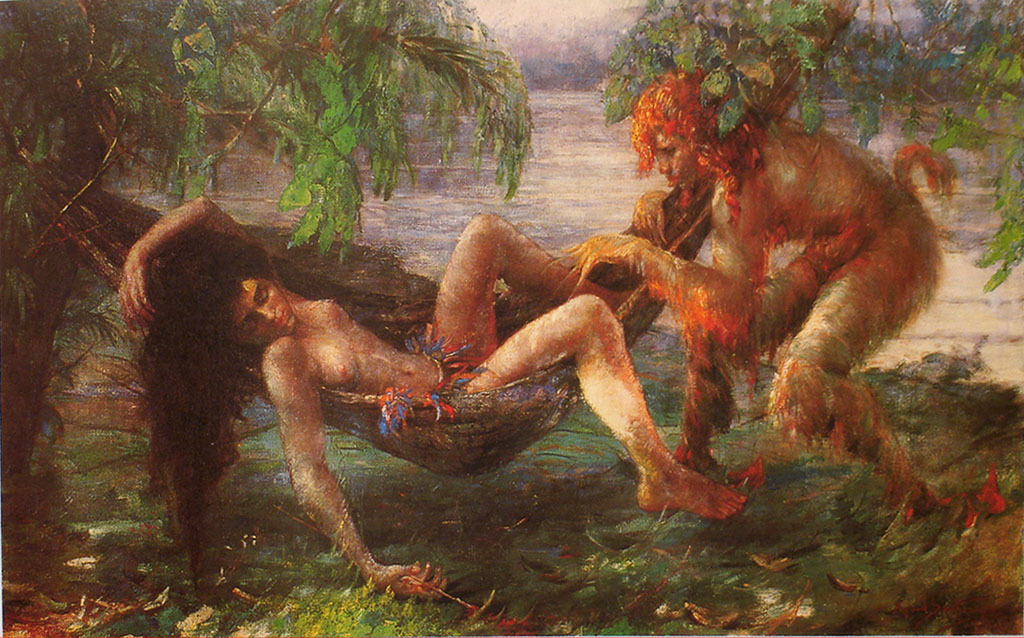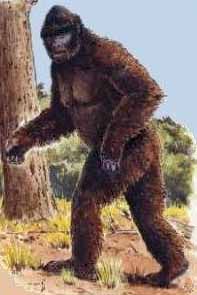Mapinguary/Mapinguari:
The Mapinguary is separated into three distinctly different types of sightings. The group of sightings centered around Brazil reports an large (reported too be larger than the American Sasquatch) foul smelling creature covered in red hair and an awful screaming cry (although some eye witnesses describe it as a shriek). It's said to be incredibly violent and has bee known to dismember cattle with its bare hands.
It is responsible for the death of many Brazilians, but it avoids major cities. This has lead researchers too believe that deforestation of the Rainforest has caused it to come into confrontation with modern Humans.
 |
| The Giant-Ground Sloth on the BBC's Walking With Beats TV series. |
It is also described as being incredibly violent but much larger and stronger with a much more Sloth like appearance, it normally seen in deep forests but is occasionally seen in small towns and villages like the Ape-like Mapinguary.
 |
| This version of the Mapinguary is woven into Brazilian mythology. |
The perhaps mos perplexing Mapinguary sightings are that of an one eyed creature with a mouth on its body (this is some times reported as a second mouth though). This creature is reported to have amazing strength like the other two as well as the red fur/hair but is said to be smaller and a strict vegetarian. It's also reported to be much less aggressive than the other two monsters.
Aluxes, Goazis and Guayazis:
 |
| A Mayan model of an Alux |
These elusive creatures are "Dwarf-like man faced"
creatures said to inhabit South America.
creatures said to inhabit South America.
This creatures are incredibly elusive and are taken very seriously by the South American population.
To even suggest these creatures may not exist is extremely offensive too those who live in small villages and towns.
 |
| A possible Alux hut? |
 |
| Artists impression of the Alux |
Aigypans, Salvaje, Achi and Vasitris:
NO IMAGES EXIST
These beings are said to be extremely dangerous, ill-tempered and carnivorous, eating men but carrying off women for breeding purposes.
Like The Mapinguary The Vasitri is supposedly incredibly violent but unlike the Mapinguary it can hunt with work with crudely made tools and is also alleged too Build, and live in, small primitive huts. It is one of the few Ape-like Wildmen too be classed as intelligent.
Matuyus and Curupiras:
 |
| Painting of A Curupiras |
A Curupira will prey on poachers and hunters that take more than they need of the forest, and he also attacks people that hunt animals that were taking care of their offspring. There are many different versions of the legend, and so the creature's appearance and habits may vary from each region in Brazil. However, Curupira is considered a nationwide folkloric figure.
Curinqueans:
 |
| Artists impression of Curinquean |
Despite this creature's ridiculous, biologically implausible size, plenty of documented tracks and eyewitness reports depict a Bigfoot of up to twenty feet tall, or perhaps even larger. Usually lean and lanky, it leaves footprints longer than twenty inches. This creature is heavily shrouded in folklore. The North American variety of true giant is often shown as related to or identical to the windigo (a cannibal giant that is sometimes also a shapeshifter) and the Curinqueans (a human shapeshifter whose only purpose is to fight the evil windigo).
Outside of America, there are other reports of hairy humanoids way bigger that most cryptozoologists would accept. To make the situation even worse, many of these creatures have characteristics associated more with folklore giants or ogres than with biological entities. Scotland's Big Gray Man is one example.
Ghana also has a legendary man-ape of extraordinary size, called the Tano giant. Louis Bowler described the creature in a 1911 book called Gold Coast Palaver as looking like a giant combination of ape and man, with arms as thick as a normal human's torso. The Tano giant is supposed to have pale skin, black fur, a monkey's head that is flat on top, and, like ogres worldwide, is blamed for devouring humans and carrying off women. The Tano giant fears fire, is reputed to be impervious to bullets, and sometimes carries a leather blanket. Some researchers think that the Tano giant is a mythologized version of the gorilla or is a new, undiscovered ape.
Another true giant is the Australian rexbeast, a variety of yowie said to leave 35-inch-long footprints. The rexbeast has been popularized in cryptozoology circles by Rex Gilroy, who says the creature also exists in Aboriginal folklore, yet he was strangely unable to find a native name for it. The rexbeast might be identical to another extra-large yowie, the quinkin of Queensland.
Reports of true giants from southeast Asia also sound much like fairy-tale ogres. The Nyalmo of Bangladesh reportedly can be 20 feet tall. This big hairy monster is associated with the yeti by some researchers, but it also has connections to werewolf-like monsters from Burma and Thailand. The Curinquean of Brazil and Paraguay is typical of South American orges. It is blamed for cattle mutilation deaths where the tongue has been removed but nothing else has been touched.

No comments:
Post a Comment